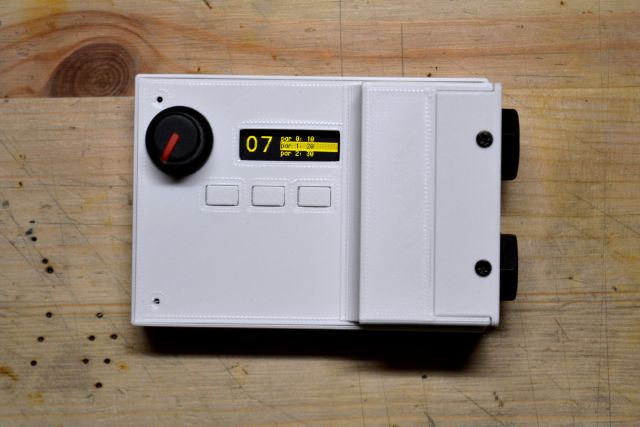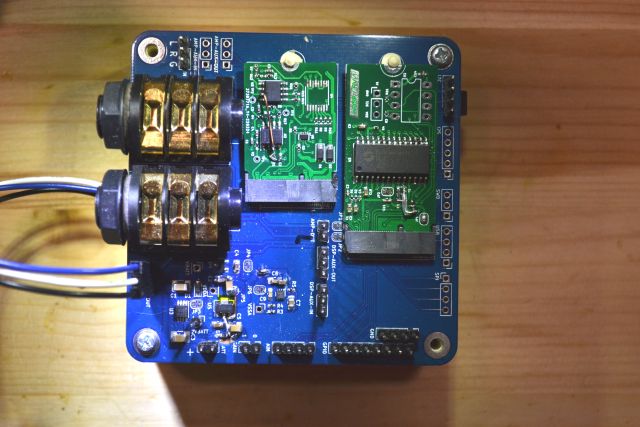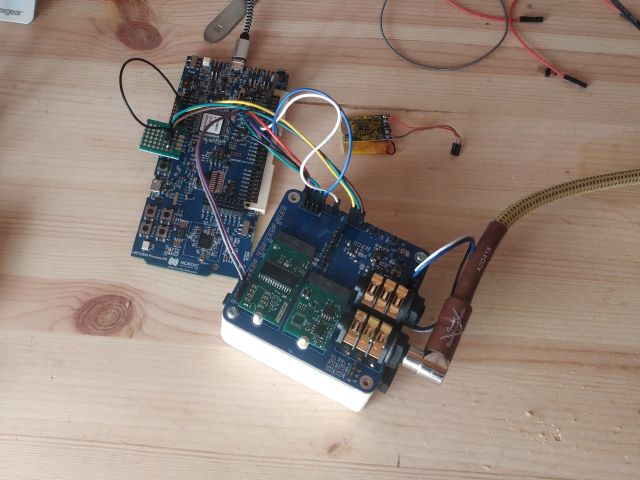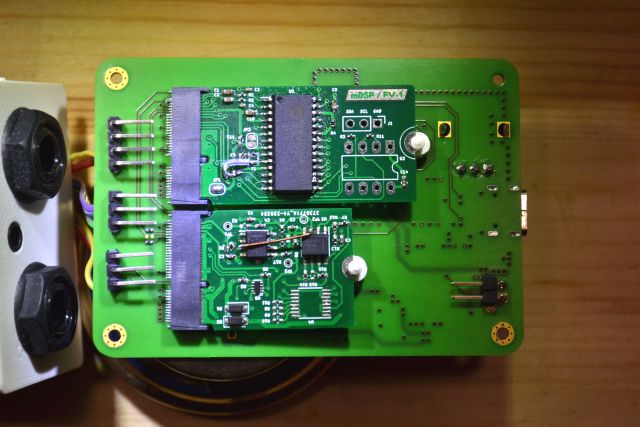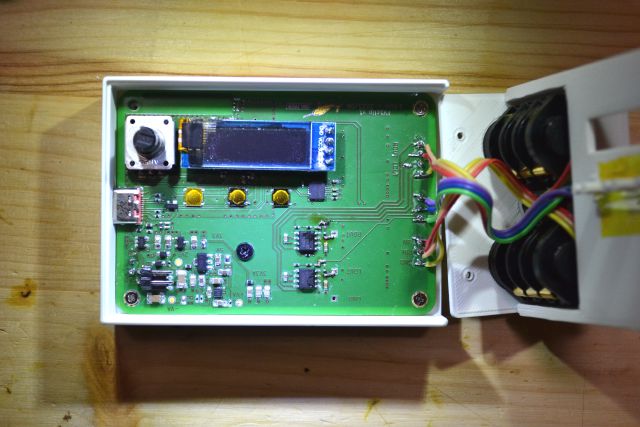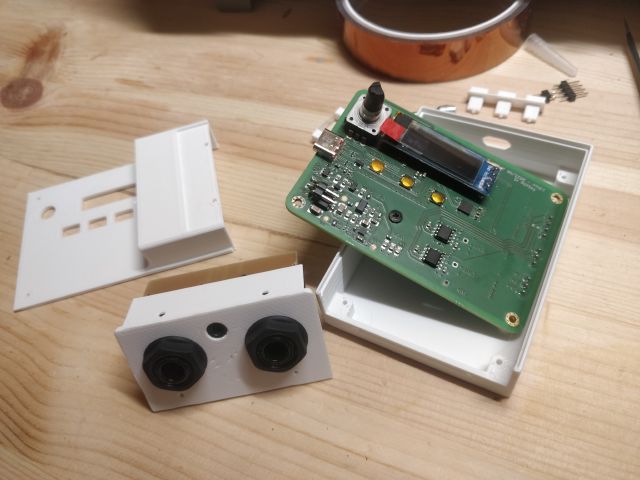FV1 clip
A wearable guitar effects processor. Based on the Spinsemi FV-1 chip.
Outline
Status
Progress as of 2024-05-11:
- Firmware
- EEPROM emulation
- Display interface
- Reading buttons/encoder
- UART program and parameter transfer
- Bluetooth program transfer
- FV1 Assembler
- DSP board
- Graphical interface
Story
Wanted a pocketable guitar effects unit. Also dissatisfied of the state I left fvpedal in.
My wishlist:
- Use of FV1 effects chip
- Setting of parameters via bluetooth
- Headphone output
- Line-in with audio passthrough
- Rechargeable battery, 5-hour runtime
- USB-C connector for power and data
- Accelerometer for controlling effects
- Easy operation (no menu diving)
Electronics
This time around I wanted to try a more modular approach to development.
A motherboard with interchangeable cards for the DSP and the pre-amp would give some good advantages:
- test the card on a “development” motherboard with more interfaces & testpoints
- swap out the cards with a more powerful or better version later
- cheaper manufacturing: the (bigger) motherboard can have lower design tolerances
Connector
The first step is choosing a connector for the cards. I wanted something I could easily re-use. Settled on a m.2 connector, with a custom pinout.
I tried my best to at least have the power rails be the same, but there are so many different m.2 standards that it proved impossible. I think at least that plugging the custom cards into a NVME port shouldn’t fry anything.
Custom m.2 pinout
| Name | Bot | Name | Top |
|---|---|---|---|
| GND | 1 | VBAT | 2 |
| GND | 3 | VBAT | 4 |
| GND | 5 | VUSB | 6 |
| GND | 7 | VUSB | 8 |
| GND | 9 | 3V3 | 10 |
| GND | 11 | 3V3 | 12 |
| GND | 13 | 1V8 | 14 |
| GND | 15 | 1V2 | 16 |
| 17 | 18 | ||
| AVNEG | 19 | AVPOS | 20 |
| 21 | 22 | ||
| AGND | 23 | KEY | |
| KEY | KEY | ||
| KEY | KEY | ||
| KEY | KEY | ||
| KEY | MCLK | 32 | |
| D+ | 33 | LRCK | 34 |
| D- | 35 | SCLK | 36 |
| GND | 37 | SDIN | 38 |
| SWDIO | 39 | SDOUT | 40 |
| SWDCLK | 41 | GND | 42 |
| MOSI | 43 | SCL0 | 44 |
| MISO | 45 | SDA0 | 46 |
| SCK | 47 | SCL1 | 48 |
| SS | 49 | SDA1 | 50 |
| GP4 | 51 | GP0 | 52 |
| GP5 | 53 | GP1 | 54 |
| GP6 | 55 | GP2 | 56 |
| GP7 | 57 | GP3 | 58 |
| AIN0 | 59 | AIN1 | 60 |
| AIN2 | 61 | AIN3 | 62 |
| GND | 63 | GND | 64 |
| AUX-LOUT | 68 | LOUT | 67 |
| AUX-ROUT | 66 | ROUT | 65 |
| AGND | 69 | AGND | 70 |
| AUX-LIN | 74 | LIN | 73 |
| AUX-RIN | 72 | RIN | 71 |
| 75 |
Motherboard
The motherboard contains the power supply, headphone amps and audio connectors. I started with a development board that allowed me to test everything worked smoothly.
I forgot the headphone amps, so hand-wired two LM386s and placed them in a box below.
Using this board I was able to develop the firmware, having easy access to all the signals and busses I needed. I used an nRF52840 devkit to do so.
The real motherboard (schematic) is smaller and has more stuff on it:
- Bluetooth SoC: nRF52840
- 6-axis motion unit: MPU-6050
- USB-C connector
- LiPo charger: STC4054
- Headphone amps: FM8002A
A neat trick is routing the SWD lines through the SBU1/2 signals. With a special adapter board, it allows attaching a debugger without taking the whole thing apart.
DSP board
The DSP is on an m.2 2245-format board. I chose the bigger size to accomodate future DSPs that might need the extra room for support components, like codecs regulators etc.
I -carefully- salvaged the FV-1 chip from the fvclip project’s PCB. I don’t even know if they sell them anymore. I also added a footprint for the EEPROM in case emulating it with the MCU would fail.
For some reason, the crystal had trouble starting up. It started up whenever I put my finger on it though. So I tried a bunch of different capacitor values, but still wouldn’t start on its own.
In the end, I ended up re-routing the XTAL signal to the connector and driving it from the microcontroller. It’s not very high, at 48kHz.
Pre-amp board
Guitar signals are very low (around 20-50mVpp), so we need a pre-amplifier board before the signal can be fed to the DSP.
This board is sized 2230, as it needs less components. There are two OPA1642 Op-Amps and an analog multiplexer for selecting the gain.
Unfortunately, forgot to order the multiplexer so had to make the gain fixed. I also had to bypass the first amp as it made the signal super-sensitive to the Guitar’s volume pot noise.
Case design
I made the case using cadquery. The 3D export from KiCad was very useful, as cadquery can import it and I could just model the case around it. Thanks to that, the print worked on the first try!
Software
The fun stuff 💻💾
There are two reasons the FVpedal project failed.
- I didn’t manage to upload custom programs to the FV1
- I had no idea how to make an assembler for the programs
There’s really something about finally having the knowledge to complete a 10-year-old project!
Made with the two best programming languages ever designed: C and Common Lisp. Fight me 🔥
Firmware
Most of the heavy lifting is done by ZephyrRTOS’s integrated drivers. Apart from the EEPROM emulation, I didn’t have to write any drivers 🥳
The input subsystem takes care of the rotary encoder and the buttons.
The character frame-buffer API combined with the ssd1306 driver make for a good enough display interface.
The EEPROM is emulated pretty easily. The only caveat is that at the time, Zephyr didn’t have support for acting as an I2C peripheral. I had to use the nrfx driver directly instead.
Commands are received over UART, using a very bare-bones wire format. The only two commands implemented are downloading a new program and changing the emulated potentiomenter values fed to the FV1.
The FV1 potentiometer inputs are driven with the world’s worst DAC, a PWM signal fed into an RC filter.
The only missing piece is generating the FV1 clock, and that’s achieved using TIMER + PPI.
static void setup_dsp_clock(void)
{
#define FVCLKPIN 22 /* P0.22 -> DSP GP5 -> FV1 X1 */
#define MYTIMER NRF_TIMER3 /* Hopefully free? */
#define CLK_HP_US 26 /* ~19kHz TODO: increase */
#define GPIOTE_CH_INVALID 0xFF
#define PPI_CH_INVALID 0xFF
/* Use TIMER + PPI + GPIOTE to synthesize a 48kHz clock on DSP GP5. We
* have to play ball and use the HAL allocation fns for PPI / GPIOTE
* since we're running in an RTOS.
*/
/* step 1: configure TIMER */
MYTIMER->BITMODE = 0; /* 16-bit width */
MYTIMER->PRESCALER = 4; /* 1 MHz - 1 us */
MYTIMER->MODE = 0; /* Timer mode */
MYTIMER->SHORTS = 1 << 0; /* CC[0] resets the timer value */
MYTIMER->CC[0] = CLK_HP_US; /* one tick = half clock cycle */
/* step 2: configure GPIOTE */
uint8_t gch = GPIOTE_CH_INVALID;
uint32_t err = nrfx_gpiote_channel_alloc(&gch);
__ASSERT_NO_MSG(err == NRFX_SUCCESS);
__ASSERT_NO_MSG(gch != GPIOTE_CH_INVALID);
NRF_GPIOTE->CONFIG[gch] = 3; /* Task mode */
NRF_GPIOTE->CONFIG[gch] |= FVCLKPIN << 8;
NRF_GPIOTE->CONFIG[gch] |= 0 << 13; /* Port 0 (line not necessary for P0) */
NRF_GPIOTE->CONFIG[gch] |= 3 << 16; /* Toggle pin on TASKS_OUT */
NRF_GPIOTE->CONFIG[gch] |= 0 << 20; /* Initial pin value is LOW */
/* step 3: configure PPI link */
uint8_t pch = PPI_CH_INVALID;
err = nrfx_ppi_channel_alloc(&pch);
__ASSERT_NO_MSG(err == NRFX_SUCCESS);
__ASSERT_NO_MSG(pch != PPI_CH_INVALID);
NRF_PPI->CH[pch].EEP = (uint32_t)&MYTIMER->EVENTS_COMPARE[0];
NRF_PPI->CH[pch].TEP = (uint32_t)&NRF_GPIOTE->TASKS_OUT[gch];
NRF_PPI->CHENSET = 1 << pch;
/* step 4: start the timer and output clock on pin */
MYTIMER->TASKS_CLEAR = 1;
MYTIMER->TASKS_START = 1;
}
FV1 Assembler
Armed with my new hammer I was in search of a nail to bang it on. Making an assembler for an obscure instruction set seemed like the perfect match for a forgotten programming language.
It’s around 500 lines of naive CL code. But hey, it works.
Features
- Assemble an FV1 program formatted in s-expressions to intel-hex format
- “Macro” assembler: s-exps are resolved recursively
- Export program to C header
- Dump all the possible instructions and their encoding
- Send assembled program over UART to DSP
Example program
soft-dist.fvl
(equ tovrx reg0)
(equ sigin reg1)
(rdax adcl 1.0)
(wrax sigin 1)
(rdax sigin 1)
(log -1 -3/16)
(exp 1 0)
(wrax tovrx 1)
(mulx tovrx)
(rdax tovrx -2)
(mulx sigin)
(sof -2 0)
(sof 1.999 0)
(wrax dacr 0)
(wrax dacl 0)
(nop)
And I used this non-sensical instruction list to test my encoding:
(and #x101) ; Some and instruction
(sof 1.0 -0.5) ; Some sof instruction
(sof .25 -.125)
(sof -0 #x7ff) ;; Some other sof instr (test list)
(sof -0 $7ff) ;; Some other sof instr (test list)
(wrax DACL 0)
(rdax ADCR 1.0)
(skp RUN jump-here-please)
; fun with parameters
(cho-rda RMP0 (bor COMPC REG #x01) (lognot (bor %0001_0000 $0C)))
(skp (bor ZRO GEZ) 2)
(equ my-alias $01)
(wldr 0 -2 my-alias)
(equ my-alias %10)
(wldr 0 -2 my-alias)
(equ my-alias 3)
(wldr 0 -2 my-alias)
; test signed int
(label jump-here-please)
(wldr 0 -32768 1)
(wldr 0 -2 1)
; memory
(mem delay-left 2048)
(mem delay-right 1024)
(rdax ADCR 1.0)
(wra delay-left 0.25)
(wra (mem-middle delay-left) 0.25)
(wra delay-left^ 0.25)
(wra (mem-end delay-right) 0.5)
(wra delay-right# 0.5)
; end-of-file
Encoding instructions
Instruction definitions are loaded from a simple text file.
Every opcode is then made an instance of the FV1-OP class:
(defclass fv1-op ()
((mnemonic :initarg :mnemonic :accessor mnemonic)
(opcode :initarg :opcode :accessor opcode)
(desc-op :initarg :desc-op :accessor desc-op)
(desc :initarg :desc :accessor desc)
(params :initarg :params :accessor params :initform nil)))
It’s a bit verbose I guess, and the accessor functions are not really necessary. This is the equivalent in python:
class Fv1Op:
def __init__(self, mnemonic, opcode, desc_op, desc, params=None):
self.mnemonic = mnemonic
self.opcode = opcode
self.desc_op = desc_op
self.desc = desc
self.params = params
Similarly, the parameters for the instruction are instances of the FV1-PARAM class
(defclass fv1-param ()
((name :initarg :name :accessor name)
(pos :initarg :pos :accessor pos)
(width :initarg :width :accessor width)
(form :initarg :form :accessor form)
(range :initarg :range :accessor range :initform nil)
(op-mne :initarg :op-mne :accessor op-mne)))
Here it how AND looks like in the text file and in the inspector:
(and #b01110 (("M" 8 24 uint nil))
"ACC & MASK"
"AND will perform a bitwise 'and' of the current ACC and the specified 24b
MASK." )
#<FV1-OP {10031E0B73}>
--------------------
Class: #<STANDARD-CLASS COMMON-LISP-USER::FV1-OP>
--------------------
Group slots by inheritance [ ]
Sort slots alphabetically [X]
All Slots:
[ ] DESC = "AND will perform a bitwise 'and' of the current ACC and the specified 24b MASK."
[ ] DESC-OP = "ACC & MASK"
[ ] MNEMONIC = AND
[ ] OPCODE = 14
[ ] PARAMS = (#<FV1-PARAM {1003522763}>)
Clicking on PARAMS in the inspector opens up the parameter list, which for this instruction only has one entry:
#<FV1-PARAM {1003522763}>
--------------------
Class: #<STANDARD-CLASS COMMON-LISP-USER::FV1-PARAM>
--------------------
Group slots by inheritance [ ]
Sort slots alphabetically [X]
All Slots:
[ ] FORM = UINT
[ ] NAME = "M"
[ ] OP-MNE = AND
[ ] POS = 8
[ ] RANGE = NIL
[ ] WIDTH = 24
